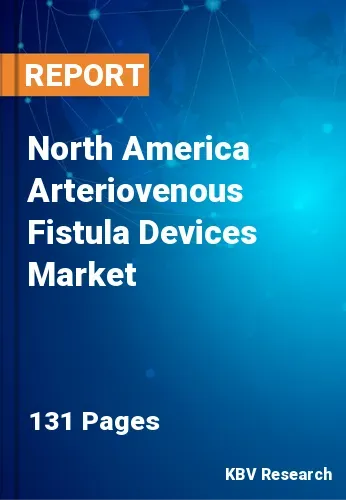The North America Arteriovenous Fistula Devices Market would witness market growth of 5.8% CAGR during the forecast period (2023-2030).
An artery and a vein can directly link, leading to an arteriovenous fistula (AVF), which results in aberrant blood flow. For those who need to undergo dialysis, these connections can be made surgically. Individuals with end-stage renal disease (ESRD) can obtain hemodialysis on a long-term basis with AVFs. Arteriovenous fistula facilitates an increased blood flow rate, which facilitates dialysis and the removal of waste materials from the body.
Due to their longevity, lesser risk of infection, and better long-term results compared to conventional alternatives like arteriovenous grafts or catheters, AVF devices are regarded as the ideal choice for vascular access. For ESRD patients to obtain vascular access and enable effective hemodialysis, these devices are essential.
Numerous reasons, including the rising incidence of ESRD and the consequent increase in the number of patients necessitating hemodialysis, are likely to contribute to the market's expected expansion. The unadjusted 5-year survival of end stage kidney disease (ESKD) or ESRD patients on kidney replacement therapy (KRT) was 41% in the USA, according to data published in 2021 by the National Library of Medicine. Hemodialysis is the most used KRT, with dialysis being the most prevalent kind in most nations.
In Canada, an estimated 1:10 British Columbians have substantial kidney disease linked to other common chronic diseases like hypertension, diabetes, and cardiovascular disease (CVD). About 4 million Canadians are affected by chronic kidney disease (CKD). The first Canadian assessment of CKD in primary care, which used data from 5 provinces throughout Canada, recently reported the prevalence of CKD to be 71 per 1000 people. According to estimates, 35.5 million, or 14% of US adults, or over 1 in 7 people, have CKD. Hence, the increasing prevalence of CKD and ESRD in this region will increase the use of AFV devices, thereby propelling the growth of the market.
The US market dominated the North America Arteriovenous Fistula Devices Market by Country in 2022, and would continue to be a dominant market till 2030; thereby, achieving a market value of $138.8 million by 2030. The Canada market is estimated to witness a CAGR of 8.2% during (2023 - 2030). Additionally, The Mexico market would register a CAGR of 7.2% during (2023 - 2030).
Based on End-use, the market is segmented into Hospitals, Ambulatory Surgical Centers and Dialysis Centers. Based on Type, the market is segmented into AVF Creation Devices (Surgical Instruments, Vascular Grafts, Angioplasty Balloons and Others), AVF Monitoring Devices (Doppler Ultrasound, Pressure Monitoring Systems, and Others) and AVF Maintenance Devices (Central Venous Catheters, Stents and Others). Based on countries, the market is segmented into U.S., Mexico, Canada, and Rest of North America.
Free Valuable Insights: The Worldwide Arteriovenous Fistula Devices Market is Projected to reach USD 521.9 Million by 2030, at a CAGR of 6.9%
The market research report covers the analysis of key stake holders of the market. Key companies profiled in the report include Medtronic PLC, Becton, Dickinson and Company, Teleflex, Inc., Fresenius Medical Care AG & Co. KGaA. (Fresenius SE & Co. KGaA), B. Braun Melsungen AG, Poly Medicure Ltd., Asahi Kasei Corporation, Laminate Medical Technologies Ltd., Cook Medical, Inc. (Cook Group), and Boston Scientific Corporation
By End-use
By Type
By Country

Our team of dedicated experts can provide you with attractive expansion opportunities for your business.

